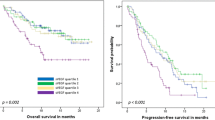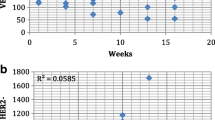Abstract
Available evidence suggests that vascular endothelial growth factor (VEGF) a potent regulator of vasculogenesis and tumor angiogenesis may be a predictor of recurrence in breast cancer patients. We sought to determine whether VEGF serum levels (VEGF-A, VEGF-C and VEGF-D) in 377 patients with malignant and benign breast tumors differ and whether there is association between vascular growth factors, clinicopathologic features and prognosis. There was no significant difference in investigated circulating angiogenic markers between patients with malignant and non malignant lesions. We found strong correlation between VEGF-A and VEGF-D and between VEGF- C and VEGF-D. Besides serum VEGF-D levels and estrogen receptor (ER) expressions no other correlations between VEGF and clinicopathologic variables were observed. However, elevated VEGF-A and VEGF-C concentrations were associated with increased number of erythrocytes, leukocytes and platelets. In Cox model values of angiogenic serum markers and recognized prognostic markers in breast cancer, VEGF-C turned out as independent prognostic factor. Our study is the first analysis showing correlation between serum concentrations of three angiogenic factors: VEGF-A, VEGF-C, VEGF-D. Associations between angiogenic cytokines and number of blood cells may be due to release of VEGF from platelets and leucocytes. Prognostic role of VEGF is still uncertain, though VEGF-C has a potential to serve as a prognostic marker.



Similar content being viewed by others
References
Kinoshita J, Kitamura K, Kabashima A, Saeki H, Tanaka S, Sugimachi K (2001) Clinical significance of vascular endothelial growth factor-C (VEGF-C) in breast cancer. Breast Cancer Res Treat 66:159–164
Heer K, Kumar H, Read J, Fox J, Monson J, Kerin M (2001) Serum vascular endothelial growth factor in breast cancer: Its relation with cancer type and estrogen receptor status. Clin Cancer Res 7:3491–3494
Mitsuhashi A, Suzuka K, Yamazawa K, Matsui H, Seki K, Sekiya S (2005) Serum vascular endothelial growth factor (VEGF) and VEGF-C levels as a tumor markers in patients with cervical carcinoma. Cancer 103:724–730
Homer J, Anyanwu K, Ell S, Greenman J, Stafford N (1999) Serum vascular endothelial growth factor in patients with head and neck squamous cell carcinoma. Clin Otolaryngol 24:426–430
Hefler L, Zeillinger R, Grimm C, Sood A, Cheng W, Gadducci A, Tempfer CB, Reinthaller A (2006) Preoperative serum vascular endothelial growth factor as a prognostic parameter in ovarian cancer. Gynecol Oncol 103:512–517
Gonzalez F, Quesada A, Sevilla I, Baca F, Medina M, Amores J, Diaz JM, Rius-Diaz F, Marques E, Alba E (2007) Prognostic value of serum angiogenic activity in colorectal cancer patients. J Cell Mol Med 11:120–128
De Vita F, Orditura M, Lieto E, Infusino S, Morgillo F, Martinelli E, Castellano P, Romano C, Ciardiello F, Catalano G, Pignatelli C, Galizia G (2004) Elevated perioperative serum vascular endothelial growth factor levels in patients with colon carcinoma. Cancer 100:270–278
Wang T, Deng M, Qiu W, Dong W (2007) Association of serum vascular endothelial growth factor –C and lymphatic vessel density with lymph node metastasis and prognosis of patients with gastric cancer. World J Gastroenterol 13:1794–1798
Tamura M, Ohta Y (2003) Serum vascular endothelial growth factor –C level in patients with primary nonsmall cell lung carcinoma. Cancer 98:1217–1222
Bando H, Weich H, Brokelmann M, Horiguchi S, Funata N, Ogawa T, Toi M (2005) Association between intratumoral free and total VEGF, soluble VEGFR-1, VEGFR-2 and prognosis in breast cancer. Br J Cancer 92:553–561
Foekens J, Peters H, Grabenchtchikov N, Look M, Meijer-van Gelder M, Geurts-Moespot A, van der Kwast TH, Sweep CG, Klijn JG (2001) High tumor levels of vascular endothelial growth factor predict poor response to systemic therapy in breast cancer. Cancer Res 61:5407–541
Granato A, Frassineti G, Giovannini N, Ballardini M, Nanni O, Maltoni R, Amadori D, Volpi A (2006) Do serum angiogenic growth factors provide additional information to that of conventional markers in monitoring the course of metastatic breast cancer? Tumor Biol 27:302–308
R development Core Team: A language and environment for statistical computing. R Foundation for Statistical Computing, Vienna, Austria. ISBN 3-900051-07-0 (2008) URL http://www.R-project.org
Konukoglu D, Turhan M, Celik V, Turna H (2007) Relation of serum vascular endothelial growth factor as an angiogenesis biomarker with nitric oxide & urokinase-type plasminogen activator in breast cancer patients. Indian J Med Res 125:747–751
Adams J, Carder P, Downey S, Forbes M, MacLennan K, Allgar V, Kaufman S, Hallam S, Bicknell R, Walker JJ, Cairnduff F, Selby PJ, Perren TJ, Lansdown M, Banks RE (2000) Vascular endothelial growth factor (VEGF) in breast cancer: comparison of plasma, serum, and tissue VEGF and microvessel density and effects of tamoxifen. Cancer Res 60:2898–2905
Mathur S, Mathur R, Gray E, Lane D, Underwood P, Kohler M, Creasman WT (2005) Serum vascular endothelial growth factor C (VEGF-C) as a specific biomarker for advanced cervical cancer: relationship to insulin-like growth factor II (IGF-II), IGF binding protein 3 (IGF-BP3) and VEGF-B. Gynecol Oncol 98:467–483
Tamura M, Oda M, Matsumoto I, Tsunezuka Y, Kawakami K, Ohta Y, Watanabe G (2004) The combination assai with circulating vascular endothelial growth factor (VEGF)-C, Matrix Metalloproteinase-9, and VEGF for diagnosing lymph node metastasis in patients with non-small cell lung cancer. Ann Surg Oncol 11:928–933
Linderholm B, Tavelin B, Grankvist K, Henriksson R (1998) Vascular endothelial growth factor is of high prognostic value in node-negative breast carcinoma. J Clin Oncol 16:3121–3128
Ryden L, Stendahl M, Jonsson H, Emdin S, Bengtsson N, Landberg G (2005) Tumor specific VEGF-A and VEGFR2 in postmenopausal breast cancer patients with long term folllow up: implication of link between VEGF pathway and tamoxifen response. Breast Cancer Res Treat 10:135–143
Ryden L, Jirstrom K, Bendahl P, Ferno M, Nordenskjold B, Stal O, Thorstenson S, Jönsson PE, Landberg G (2005) Tumor specific expression of vascular endothelial growth factor receptor 2 but not vascular endothelial growth factor or human epidermal growth factor receptor 2 is associated with impaired response to adjuvant tamoxifen in premenopausal breast cancer. J Clin Oncol 23:4695–4704
Svensson S, Jirstrom K, Ryden L, Roos G, Emdin S, Ostrowski M, Landberg G (2005) ERK phosphorylation is linked to VEGFR2 expression and Ets-2 pphosphorylation in breast cancer and is assocoated with tamoxifen resistance and small tumors with good prognosis. Oncogene 24:4370–4379
Werther K, Christensen I, Nielsen H (2002) Determination of vascular endothelial growth factor (VEGF) in circulating blood: significance of VEGF in various leucocytes and platelets. Scand J Clin Lab Invest 62:343–350
Kut C, Gabhann F, Popel A (2007) Where is VEGF in the body? A meta-analysis of VEGF distribution in cancer. Br J Cancer 97:978–985
Kusumanto Y, Dam W, Hospers G, Meijer C, Mulder N (2003) Platelets and granulocytes, in particular the neutrophils, form important compartments for circulating vascular endothelial growth factor. Angiogenesis 6:283–287
Yang W, Klos K, Yang Y, Smith T, Shi D, Yu D (2002) ErbB2 overexpression correlates with increased expression of vascular endothelial growth factors A, C, and D in human breast carcinoma. Cancer 94:2855–2861
Author information
Authors and Affiliations
Corresponding author
Rights and permissions
About this article
Cite this article
Gisterek, I., Matkowski, R., Lacko, A. et al. Serum Vascular Endothelial Growth Factors A, C and D in Human Breast Tumors. Pathol. Oncol. Res. 16, 337–344 (2010). https://doi.org/10.1007/s12253-009-9211-8
Received:
Accepted:
Published:
Issue Date:
DOI: https://doi.org/10.1007/s12253-009-9211-8




